System MITSUBISHI ECLIPSE CROSS 2019 Owner's Manual (in English)
[x] Cancel search | Manufacturer: MITSUBISHI, Model Year: 2019, Model line: ECLIPSE CROSS, Model: MITSUBISHI ECLIPSE CROSS 2019Pages: 423, PDF Size: 75.41 MB
Page 359 of 423
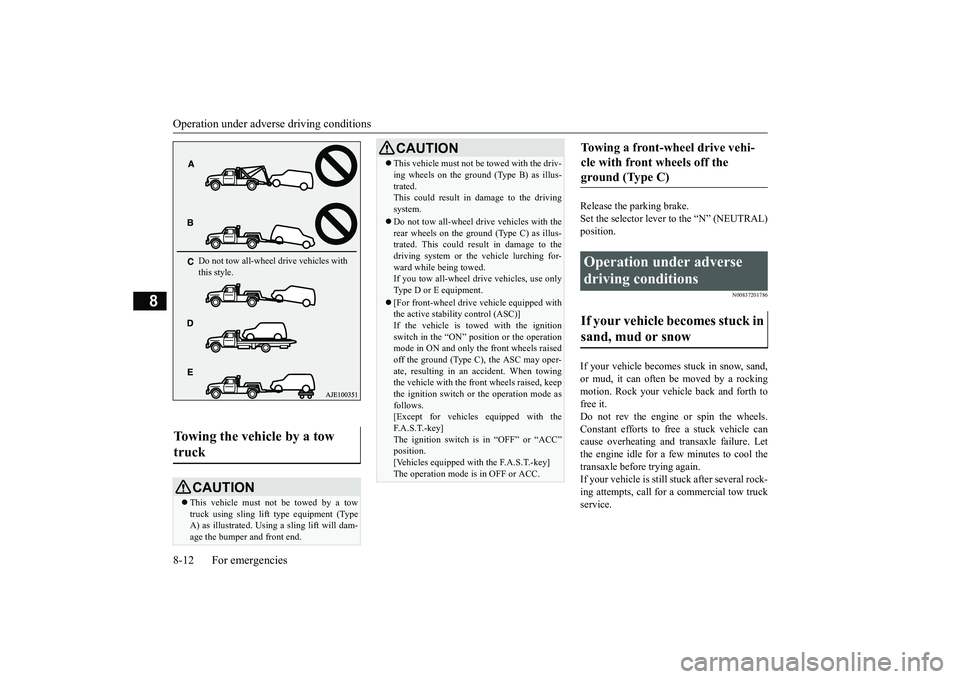
Operation under adverse driving conditions 8-12 For emergencies
8
Release the parking brake. Set the selector lever to the “N” (NEUTRAL) position.
N00837201786
If your vehicle becomes stuck in snow, sand,or mud, it can often be moved by a rocking motion. Rock your vehicle back and forth tofree it. Do not rev the engine or spin the wheels. Constant efforts to free a stuck vehicle cancause overheating and transaxle failure. Let the engine idle for a few minutes to cool the transaxle before trying again.If your vehicle is still stuck after several rock- ing attempts, call for a commercial tow truck service.
Towing the vehicle by a tow truck
CAUTION This vehicle must not be towed by a tow truck using sling lift type equipment (Type A) as illustrated. Using a sling lift will dam-age the bumper and front end.Do not tow all-wheel drive vehicles with this style.
This vehicle must not be towed with the driv- ing wheels on the ground
(Type B) as illus-
trated. This could result in damage to the driving system. Do not tow all-wheel drive vehicles with the rear wheels on the ground (Type C) as illus-trated. This could result in damage to the driving system or the vehicle lurching for- ward while being towed.If you tow all-wheel drive vehicles, use only Type D or E equipment. [For front-wheel drive vehicle equipped with the active stability control (ASC)] If the vehicle is towed with the ignitionswitch in the “ON” position or the operation mode in ON and only the front wheels raised off the ground (Type C), the ASC may oper-ate, resulting in an accident. When towing the vehicle with the front wheels raised, keep the ignition switch or the operation mode asfollows. [Except for vehicles equipped with the F. A . S . T. - k e y ]The ignition switch is in “OFF” or “ACC” position. [Vehicles equipped with the F.A.S.T.-key] The operation mode is in OFF or ACC.CAUTION
Towing a front-wheel drive vehi- cle with front wheels off the ground (Type C) Operation under adverse driving conditions If your vehicle becomes stuck in sand, mud or snow
BK0266800US.bo
ok 12 ページ 2018年6月27日 水曜日 午後5時6分
Page 360 of 423
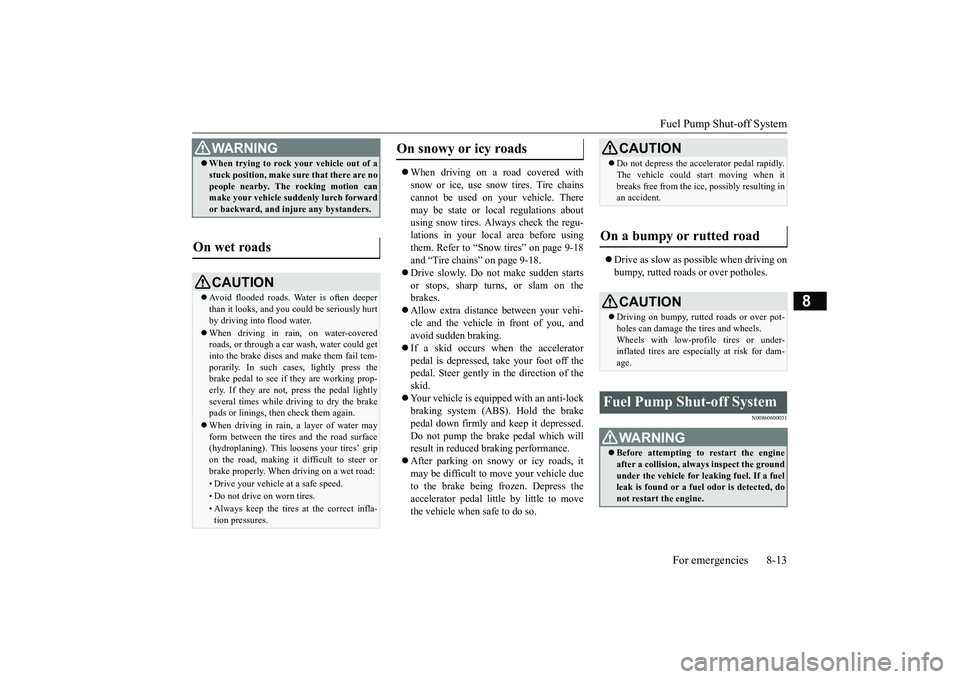
Fuel Pump Shut-off System
For emergencies 8-13
8
When driving on a road covered with snow or ice, use snow tires. Tire chains cannot be used on your vehicle. Theremay be state or local regulations about using snow tires. Always check the regu- lations in your local area before usingthem. Refer to “Snow tires” on page 9-18 and “Tire chains” on page 9-18. Drive slowly. Do not make sudden starts or stops, sharp turns, or slam on thebrakes. Allow extra distance between your vehi- cle and the vehicle in front of you, andavoid sudden braking. If a skid occurs when the accelerator pedal is depressed, take your foot off thepedal. Steer gently in the direction of the skid. Your vehicle is equipped with an anti-lock braking system (ABS). Hold the brake pedal down firmly and keep it depressed. Do not pump the brake pedal which willresult in reduced braking performance. After parking on snowy or icy roads, it may be difficult to move your vehicle dueto the brake being frozen. Depress the accelerator pedal little by little to move the vehicle when safe to do so.
Drive as slow as poss
ible when driving on
bumpy, rutted roads or over potholes.
N00860600031
WA R N I N G When trying to rock your vehicle out of a stuck position, make sure that there are no people nearby. The rocking motion can make your vehicle suddenly lurch forward or backward, and injure any bystanders.
On wet roads
CAUTION Avoid flooded roads. Water is often deeper than it looks, and you could be seriously hurt by driving into flood water. When driving in rain, on water-covered roads, or through a car wash, water could getinto the brake discs and make them fail tem- porarily. In such cases, lightly press the brake pedal to see if they are working prop-erly. If they are not, press the pedal lightly several times while driving to dry the brake pads or linings, then check them again. When driving in rain, a layer of water may form between the tires and the road surface(hydroplaning). This loosens your tires’ grip on the road, making it difficult to steer or brake properly. When driving on a wet road:• Drive your vehicle at a safe speed.• Do not drive on worn tires.• Always keep the tires at the correct infla- tion pressures.
On snowy or icy roads
CAUTION Do not depress the accelerator pedal rapidly. The vehicle could start moving when it breaks free from the ice, possibly resulting in an accident.
On a bumpy or rutted road
CAUTION Driving on bumpy, rutted roads or over pot- holes can damage the tires and wheels. Wheels with low-profile tires or under- inflated tires are especially at risk for dam-age.
Fuel Pump Shut-off System
WA R N I N G Before attempting to restart the engine after a collision, always inspect the ground under the vehicle for leaking fuel. If a fuel leak is found or a fuel odor is detected, donot restart the engine.
BK0266800US.bo
ok 13 ページ 2018年6月27日 水曜日 午後5時6分
Page 361 of 423
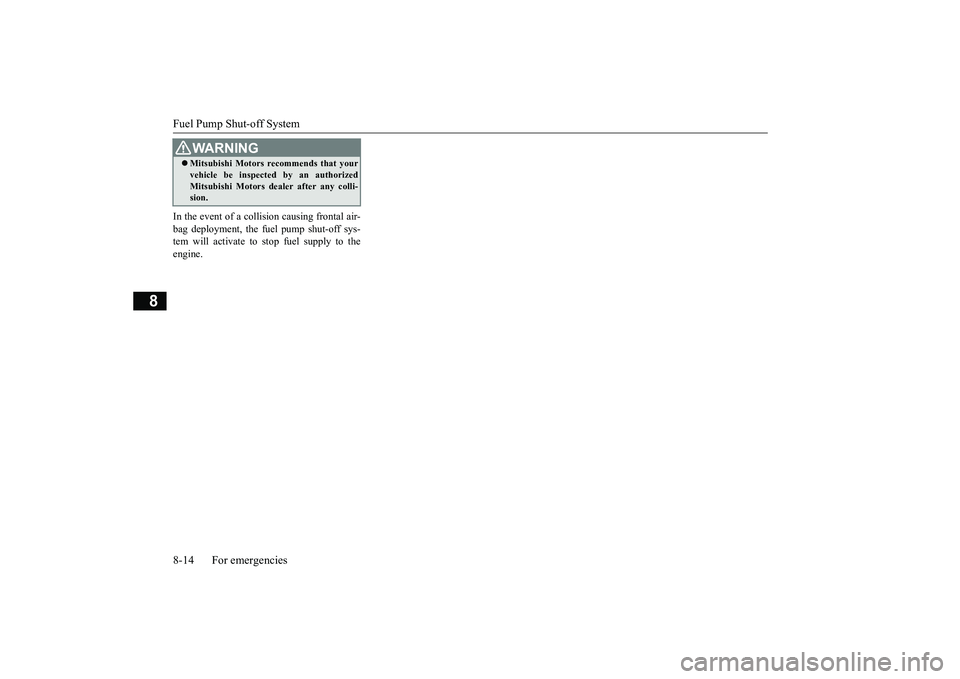
Fuel Pump Shut-off System 8-14 For emergencies
8
In the event of a collis
ion causing frontal air-
bag deployment, the fuel pump shut-off sys- tem will activate to stop fuel supply to the engine. Mitsubishi Motors recommends that your vehicle be inspected by an authorized Mitsubishi Motors dealer after any colli- sion.WA R N I N G
BK0266800US.bo
ok 14 ページ 2018年6月27日 水曜日 午後5時6分
Page 362 of 423
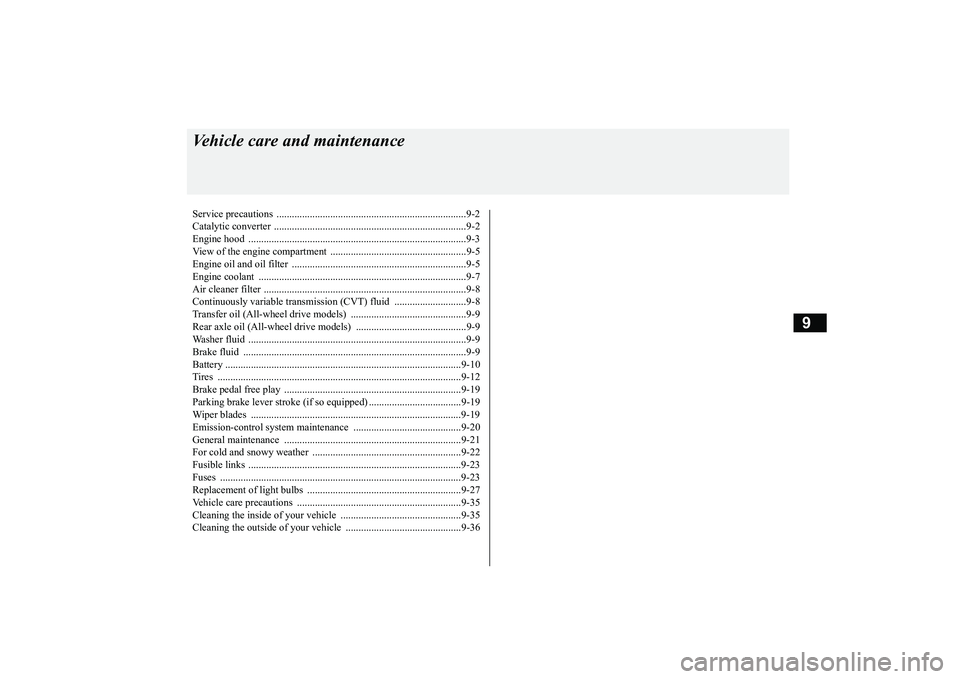
9
Vehicle care and maintenanceService precautions .........
.................................................................9-2
Catalytic converter
.................................................
..........................9-2
Engine hood ..............................
.......................................................9-3
View of the engine comp
artment .....................................................9-5
Engine oil and oil filt
er ................................
....................................9-5
Engine coolant ................
.................................................................9-7
Air cleaner filter ....
.................................................
..........................9-8
Continuously variable transmis
sion (CVT) fluid ............................9-8
Transfer oil (All-wheel dr
ive models) .............................................9-9
Rear axle oil (All-wheel dr
ive models) ...........................................9-9
Washer fluid ....................
.................................................................9-9
Brake fluid ......................
.................................................................9-9
Battery .......................................
.....................................................9-10
Tires ..........................................
.....................................................9-12
Brake pedal free play
.............................................
........................9-19
Parking brake lever stroke (if so equipped) ....................................9-19Wiper blades ...................
...............................................................9-19
Emission-control system maintenance ..........................................9-20 General maintenance
.............................................
........................9-21
For cold and snowy weat
her ..........................................................9-22
Fusible links ....................
...............................................................9-23
Fuses .........................................
.....................................................9-23
Replacement of light bu
lbs ............................................................9-27
Vehicle care precautions
........................................
........................9-35
Cleaning the inside of your
vehicle ...............................................9-35
Cleaning the outside of your
vehicle .............................................9-36
BK0266800US.bo
ok 1 ページ 2018年6月27日 水曜日 午後5時6分
Page 368 of 423
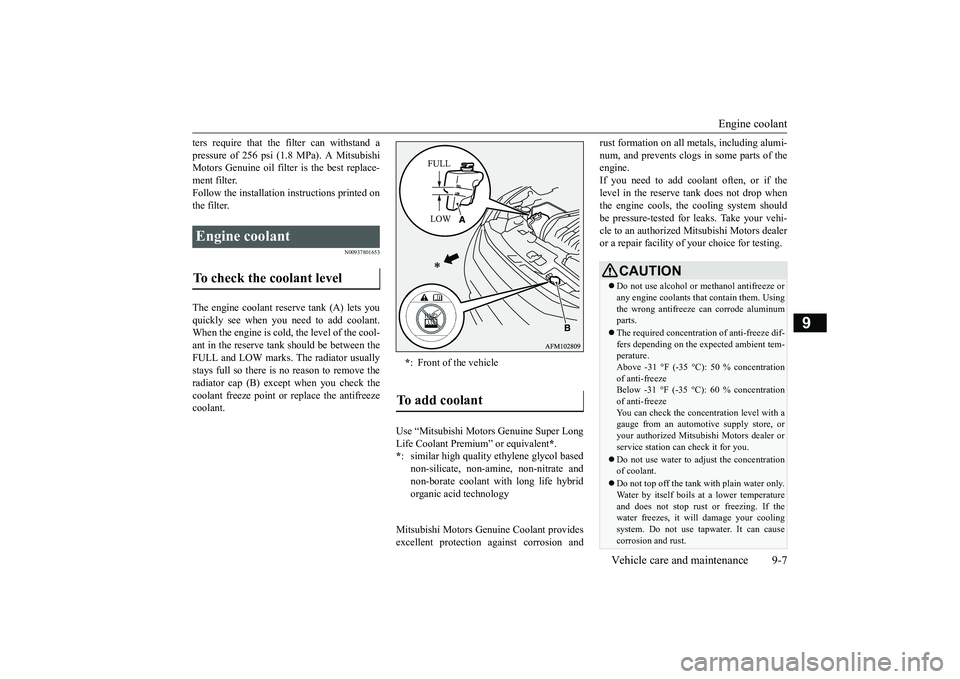
Engine coolant
Vehicle care and maintenance 9-7
9
ters require that the filter can withstand a pressure of 256 psi (1.8 MPa). A Mitsubishi Motors Genuine oil filter is the best replace- ment filter.Follow the installation
instructions printed on
the filter.
N00937801653
The engine coolant reserve tank (A) lets you quickly see when you need to add coolant. When the engine is cold, the level of the cool- ant in the reserve tank should be between theFULL and LOW marks. The radiator usually stays full so there is no reason to remove the radiator cap (B) except when you check thecoolant freeze point or replace the antifreeze coolant.
Mitsubishi Motors Genuine Coolant provides excellent protection against corrosion and
rust formation on all metals, including alumi- num, and prevents clogs in some parts of the engine. If you need to add co
olant often, or if the
level in the reserve tank does not drop when the engine cools, the cooling system should be pressure-tested for leaks. Take your vehi-cle to an authorized Mitsubishi Motors dealer or a repair facility of your choice for testing.
Engine coolant To check the coolant level
* : Front of the vehicle
To add coolant Use “Mitsubishi Motors Genuine Super Long Life Coolant Premium” or equivalent
*.
* : similar high quality ethylene glycol based non-silicate, non-amine, non-nitrate and non-borate coolant with long life hybridorganic acid technology
FULL LOW
CAUTION Do not use alcohol or methanol antifreeze or any engine coolants that contain them. Using the wrong antifreeze can corrode aluminum parts. The required concentration of anti-freeze dif- fers depending on the expected ambient tem-perature. Above -31 °F (-35 °C): 50 % concentration of anti-freezeBelow -31 °F (-35 °C): 60 % concentration of anti-freeze You can check the concentration level with agauge from an automotive supply store, or your authorized Mitsubishi Motors dealer or service station can check it for you. Do not use water to adjust the concentration of coolant. Do not top off the tank with plain water only. Water by itself boils at a lower temperature and does not stop rust or freezing. If the water freezes, it will damage your coolingsystem. Do not use tapwater. It can cause corrosion and rust.
BK0266800US.bo
ok 7 ページ 2018年6月27日 水曜日 午後5時6分
Page 370 of 423
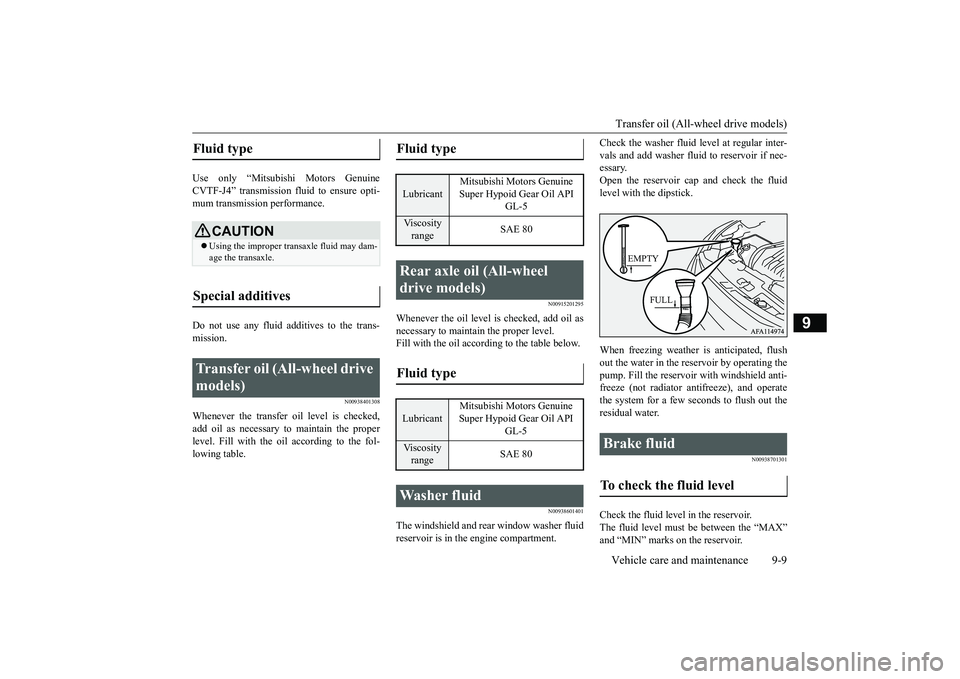
Transfer oil (All-wheel drive models) Vehicle care and maintenance 9-9
9
Use only “Mitsubishi Motors Genuine CVTF-J4” transmission fluid to ensure opti-mum transmission performance. Do not use any fluid additives to the trans- mission.
N00938401308
Whenever the transfer oil level is checked,add oil as necessary to maintain the proper level. Fill with the oil according to the fol-lowing table.
N00915201295
Whenever the oil level is checked, add oil asnecessary to maintain the proper level.Fill with the oil according to the table below.
N00938601401
The windshield and rear window washer fluid reservoir is in the engine compartment.
Check the washer fluid level at regular inter- vals and add washer fluid to reservoir if nec- essary. Open the reservoir cap and check the fluidlevel with the dipstick. When freezing weather is anticipated, flush out the water in the reservoir by operating thepump. Fill the reservoir with windshield anti-freeze (not radiator antifreeze), and operate the system for a few seconds to flush out the residual water.
N00938701301
Check the fluid level in the reservoir.The fluid level must be between the “MAX”and “MIN” marks on the reservoir.
Fluid type
CAUTION Using the improper transaxle fluid may dam- age the transaxle.
Special additives Transfer oil (All-wheel drive models)
Fluid type Lubricant
Mitsubishi Motors Genuine Super Hypoid Gear Oil API
GL-5
Viscosity range
SAE 80
Rear axle oil (All-wheel drive models) Fluid type Lubricant
Mitsubishi Motors Genuine Super Hypoid Gear Oil API
GL-5
Viscosity range
SAE 80
Washer fluid
Brake fluid To check the fluid level
FULL
EMPTY
BK0266800US.bo
ok 9 ページ 2018年6月27日 水曜日 午後5時6分
Page 371 of 423
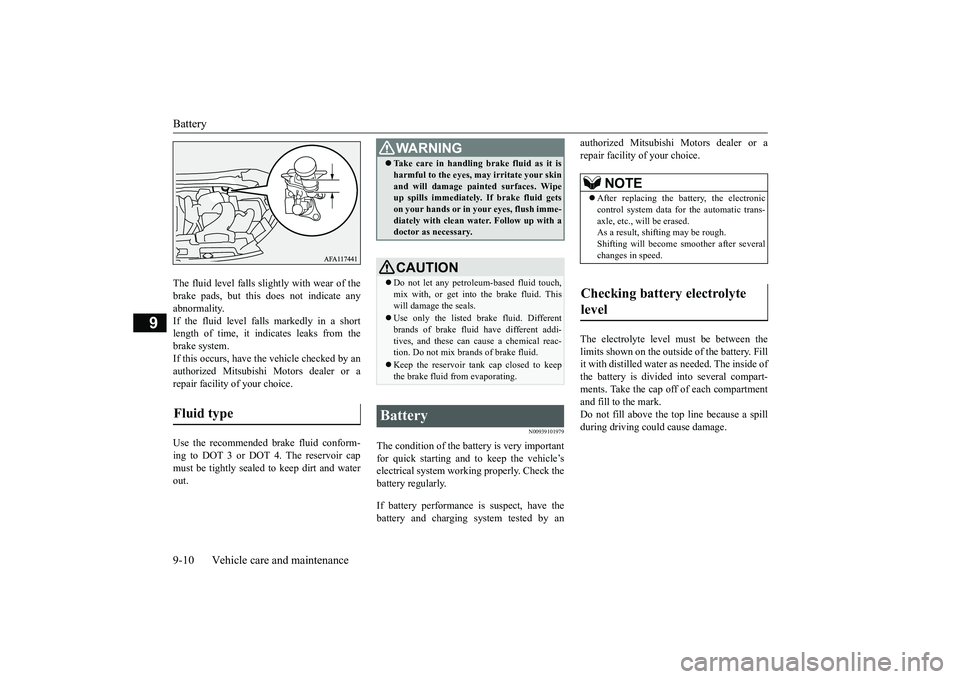
Battery 9-10 Vehicle care and maintenance
9
The fluid level falls slightly with wear of the brake pads, but this does not indicate anyabnormality. If the fluid level falls markedly in a short length of time, it indicates leaks from thebrake system. If this occurs, have the vehicle checked by an authorized Mitsubishi Motors dealer or arepair facility of your choice. Use the recommended brake fluid conform- ing to DOT 3 or DOT 4. The reservoir capmust be tightly sealed to keep dirt and water out.
N00939101979
The condition of the battery is very important for quick starting and to keep the vehicle’selectrical system working properly. Check the battery regularly. If battery performance is suspect, have the battery and charging system tested by an
authorized Mitsubishi Motors dealer or a repair facility of your choice. The electrolyte level must be between the limits shown on the outside of the battery. Fill it with distilled water as needed. The inside ofthe battery is divided into several compart- ments. Take the cap off of each compartment and fill to the mark.Do not fill above the top line because a spill during driving could cause damage.
Fluid type
WA R N I N G Take care in handling brake fluid as it is harmful to the eyes, may irritate your skin and will damage painted surfaces. Wipe up spills immediately. If brake fluid gets on your hands or in your eyes, flush imme-diately with clean water. Follow up with a doctor as necessary.CAUTION Do not let any petroleum-based fluid touch, mix with, or get into the brake fluid. This will damage the seals. Use only the listed brake fluid. Different brands of brake fluid have different addi- tives, and these can cause a chemical reac-tion. Do not mix brands of brake fluid. Keep the reservoir tank cap closed to keep the brake fluid from evaporating.
Battery
NOTE
After replacing the battery, the electronic control system data for the automatic trans- axle, etc., will be erased.As a result, shifting may be rough. Shifting will become smoother after several changes in speed.
Checking battery electrolyte level
BK0266800US.bo
ok 10 ページ 2018年6月27日 水曜日 午後5時6分
Page 372 of 423
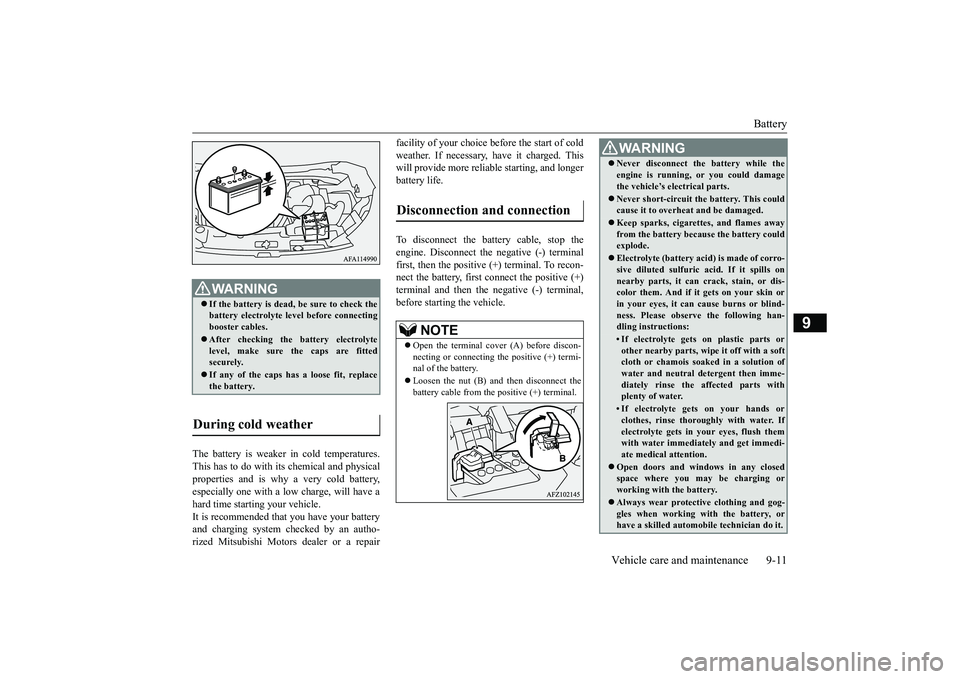
Battery
Vehicle care and maintenance 9-11
9
The battery is weaker in cold temperatures. This has to do with its chemical and physical properties and is why a very cold battery, especially one with a low charge, will have ahard time starting your vehicle. It is recommended that you have your battery and charging system checked by an autho-rized Mitsubishi Motors dealer or a repair
facility of your choice before the start of cold weather. If necessary, have it charged. This will provide more reliable starting, and longer battery life. To disconnect the battery cable, stop the engine. Disconnect the negative (-) terminalfirst, then the positive (+) terminal. To recon-nect the battery, first connect the positive (+) terminal and then the negative (-) terminal, before starting the vehicle.
WA R N I N G If the battery is dead, be sure to check the battery electrolyte level before connecting booster cables. After checking the battery electrolyte level, make sure the caps are fitted securely. If any of the caps has a loose fit, replace the battery.
During cold weather
Disconnection and connection
NOTE
Open the terminal cover (A) before discon- necting or connecting the positive (+) termi- nal of the battery. Loosen the nut (B) and then disconnect the battery cable from the positive (+) terminal.
WA R N I N G Never disconnect the battery while the engine is running, or you could damage the vehicle’s electrical parts. Never short-circuit the battery. This could cause it to overheat and be damaged. Keep sparks, cigarettes, and flames away from the battery because the battery could explode. Electrolyte (battery acid) is made of corro- sive diluted sulfuric
acid. If it spills on
nearby parts, it can crack, stain, or dis-color them. And if it gets on your skin or in your eyes, it can cause burns or blind- ness. Please observe the following han-dling instructions:• If electrolyte gets on plastic parts orother nearby parts, wi
pe it off with a soft
cloth or chamois soaked in a solution of water and neutral detergent then imme-diately rinse the affected parts with plenty of water.• If electrolyte gets on your hands orclothes, rinse thoroughly with water. If electrolyte gets in your eyes, flush themwith water immediately and get immedi- ate medical attention.
Open doors and windows in any closed space where you may be charging or working with the battery. Always wear protective clothing and gog- gles when working with the battery, or have a skilled automobile technician do it.
BK0266800US.bo
ok 11 ページ 2018年6月27日 水曜日 午後5時6分
Page 377 of 423
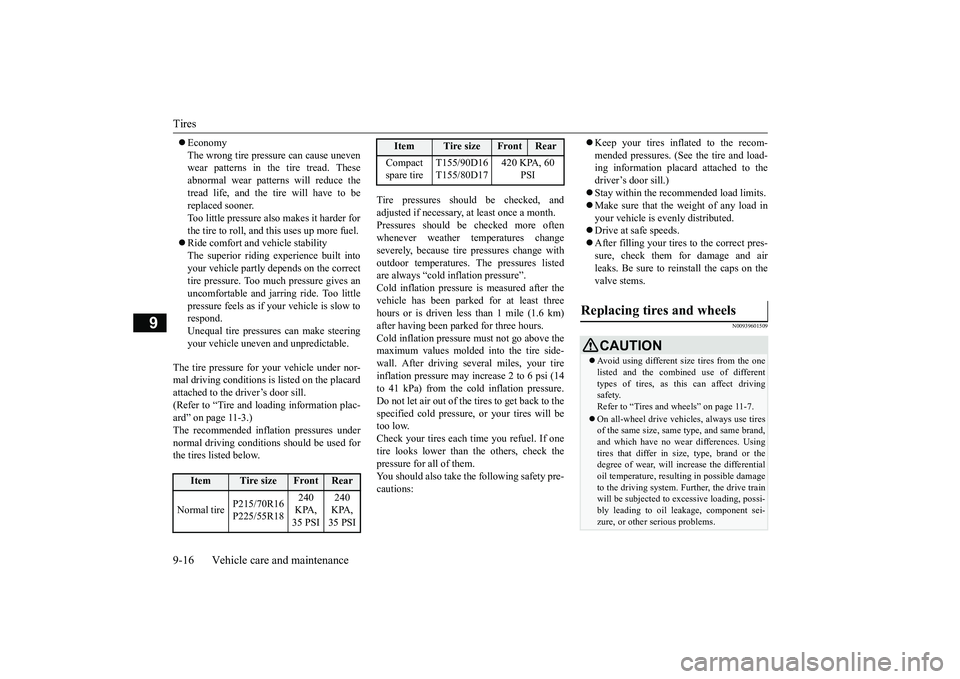
Tires 9-16 Vehicle care and maintenance
9
Economy The wrong tire pressure can cause uneven wear patterns in the tire tread. These abnormal wear patterns will reduce thetread life, and the tire will have to be replaced sooner. Too little pressure also makes it harder forthe tire to roll, and this uses up more fuel. Ride comfort and vehicle stability The superior riding experience built intoyour vehicle partly depends on the correcttire pressure. Too much pressure gives an uncomfortable and jarring ride. Too little pressure feels as if your vehicle is slow torespond. Unequal tire pressures can make steering your vehicle uneven and unpredictable.
The tire pressure for your vehicle under nor- mal driving conditions is listed on the placard attached to the driver’s door sill. (Refer to “Tire and loading information plac-ard” on page 11-3.) The recommended infl
ation pressures under
normal driving conditions should be used forthe tires listed below.
Tire pressures should be checked, and adjusted if necessary, at least once a month. Pressures should be checked more often whenever weather temperatures changeseverely, because tire pressures change with outdoor temperatures. The pressures listed are always “cold inflation pressure”.Cold inflation pressure is measured after the vehicle has been parked for at least three hours or is driven less than 1 mile (1.6 km)after having been parked for three hours.Cold inflation pressure must not go above the maximum values molded into the tire side- wall. After driving several miles, your tireinflation pressure may increase 2 to 6 psi (14 to 41 kPa) from the cold inflation pressure. Do not let air out of the tires to get back to thespecified cold pressure, or your tires will be too low. Check your tires each time you refuel. If onetire looks lower than the others, check the pressure for all of them. You should also take the following safety pre-cautions:
Keep your tires inflated to the recom- mended pressures. (See the tire and load- ing information placard attached to the driver’s door sill.) Stay within the recommended load limits. Make sure that the weight of any load in your vehicle is evenly distributed. Drive at safe speeds. After filling your tires to the correct pres- sure, check them for damage and airleaks. Be sure to reinstall the caps on thevalve stems.
N00939601509
Item
Tire size
Front
Rear
Normal tire
P215/70R16 P225/55R18
240 KPA, 35 PSI
240 KPA, 35 PSI
Compact spare tire
T155/90D16 T155/80D17
420 KPA, 60
PSI
Item
Tire size
Front
Rear
Replacing tires and wheels
CAUTION Avoid using different si
ze tires from the one
listed and the combined use of different types of tires, as this can affect drivingsafety. Refer to “Tires and wheels” on page 11-7. On all-wheel drive vehicles, always use tires of the same size, same type, and same brand, and which have no wear differences. Usingtires that differ in size, type, brand or the degree of wear, will increase the differential oil temperature, resulting in possible damage to the driving system. Further, the drive train will be subjected to excessive loading, possi-bly leading to oil leakage, component sei- zure, or other serious problems.
BK0266800US.bo
ok 16 ページ 2018年6月27日 水曜日 午後5時6分
Page 381 of 423
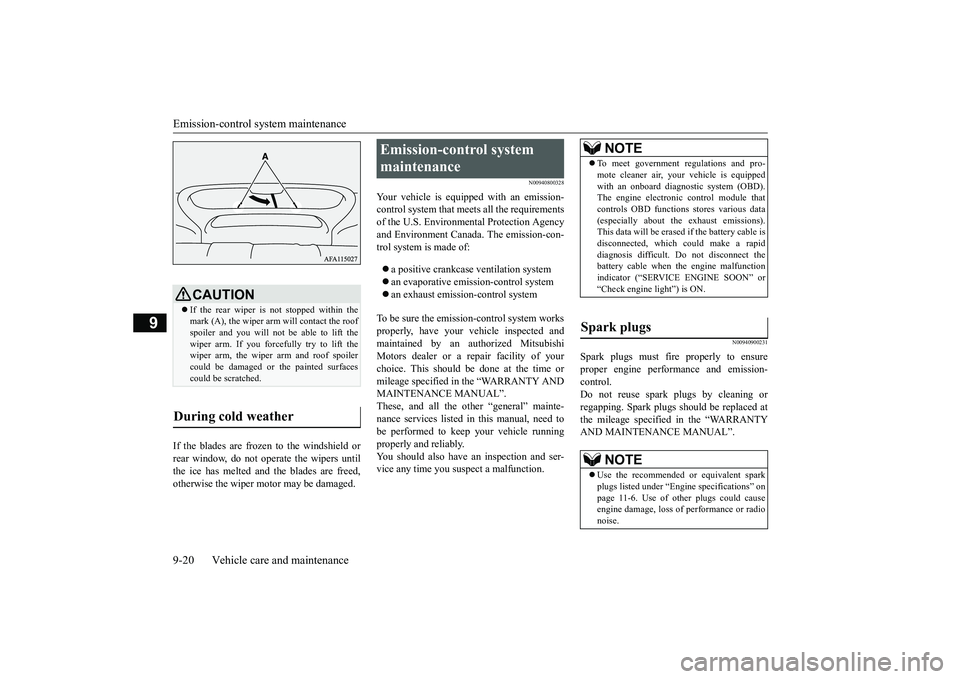
Emission-control system maintenance 9-20 Vehicle care and maintenance
9
If the blades are frozen to the windshield or rear window, do not operate the wipers until the ice has melted and the blades are freed,otherwise the wiper motor may be damaged.
N00940800328
Your vehicle is equipped with an emission-control system that meets all the requirementsof the U.S. Environmental Protection Agency and Environment Canada. The emission-con- trol system is made of: a positive crankcase ventilation system an evaporative emission-control system an exhaust emission-control system
To be sure the emission-control system works properly, have your vehicle inspected and maintained by an authorized MitsubishiMotors dealer or a repair facility of your choice. This should be done at the time or mileage specified in the “WARRANTY ANDMAINTENANCE MANUAL”. These, and all the other “general” mainte- nance services listed in this manual, need tobe performed to keep your vehicle running properly and reliably. You should also have an inspection and ser-vice any time you suspect a malfunction.
N00940900231
Spark plugs must fire properly to ensureproper engine performance and emission-control. Do not reuse spark plugs by cleaning or regapping. Spark plugs should be replaced atthe mileage specified in the “WARRANTY AND MAINTENANCE MANUAL”.
CAUTION If the rear wiper is not stopped within the mark (A), the wiper arm will contact the roofspoiler and you will not be able to lift the wiper arm. If you forcefully try to lift the wiper arm, the wiper arm and roof spoilercould be damaged or the painted surfaces could be scratched.
During cold weather
Emission-control system maintenance
NOTE
To meet government regulations and pro- mote cleaner air, your vehicle is equipped with an onboard diagnostic system (OBD). The engine electronic control module that controls OBD functions stores various data(especially about the exhaust emissions). This data will be erased if the battery cable is disconnected, which could make a rapiddiagnosis difficult. Do not disconnect the battery cable when the engine malfunction indicator (“SERVICE ENGINE SOON” or“Check engine light”) is ON.
Spark plugs
NOTE
Use the recommended or equivalent spark plugs listed under “Engine specifications” on page 11-6. Use of other plugs could cause engine damage, loss of performance or radionoise.
BK0266800US.bo
ok 20 ページ 2018年6月27日 水曜日 午後5時6分